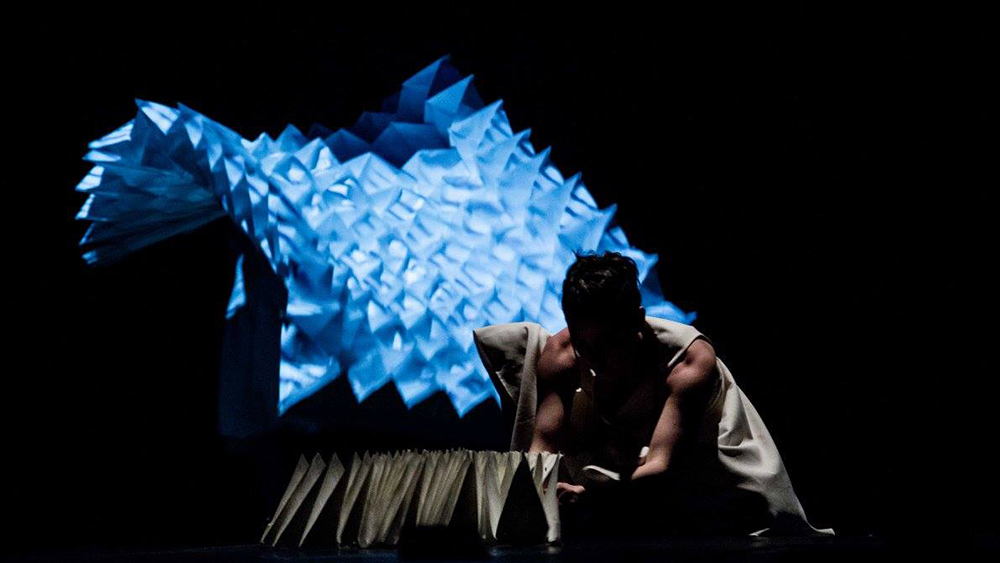

We are bombarded daily with a barrage of information, misinformation, and crises. How does one respond to this bombardment?
Following our work together on the 2010 Dance of Forgotten Steps, the seeds for ASCENDance began with conversations between sculptor Barbara Cooper and me and soon thereafter with video designer Petra Bachmaier. We imagined a dance that explored meditative forms, such as labyrinths and mandalas as a response to the daily assault of information and images. We began by examining forms in the natural world, such as the growth form of plants. How leaves begin as a tight, folded bud and unfold and grow into various fully formed shapes, then change again until they die and return to the earth. We also researched how small, confined structures such as formal garden labyrinths or corn mazes became ritualized paths for practicing meditation and reflection.
In developing the work, we decided that Barbara would create objects that the dancers could dance with and around, and that would, at the same time, transform the space. The objects needed to be lightweight, compact, and fluid—yet be large enough to have a presence on the stage. That fall of 2012, I traveled to Florida, where Barbara was in-residence at the Studios in Key West. We spent our time together exploring the wide range of forms that develop from paper folding. Following our research and discussion, Barbara produced the folded zig-zag origami structures in two sizes, four structures of 60 inches and one about 30 inches. Later, she created the stunning central image of the dance—the star shaped circle in the square—built out of the same process and hung on a moveable metal armature.
That’s where the dance began. As a choreographer, I worked on how to create metaphors through the relationship of the body to objects. It’s a two-way street, movement upends the perception of the objects, animating the inanimate; and objects lend metaphor to movement. Barbara’s moveable folded paper structures also shaped the space and created spaces and pathways within the stage space.
The dancers and I developed movement from the concept of folding and unfolding, revealing and concealing. The dancers had to work to familiarize themselves with the structure’s weight, shape, and movement. We spent a long time experimenting with manipulating and modeling the structures. Many times we would come up with interesting material that we couldn’t repeat because the paper would not cooperate or the props would not return to their original folded shape. Once we developed movement sequences, we began to experiment with video projections onto the structures, the stage space, and the dancers. We performed the work in progress at several sites throughout Chicago, such as the Drucker Center and the Pritzker Pavilion, to garner audience feedback as we built the full dance.
I formed ASCENDance into five sections: the opening dance with the star medallion, the frenzied building dance with the folded linear structures, the duet, the group section with the open, transforming structures, and the slow ritualized metamorphic dance at the end.
At that point, composer Matthew Ferraro came into the picture. Matthew was interested in working on a dance production and contacted me on a visit to Chicago. I discussed ASCENDance with him and introduced him to Barbara, Petra and the dancers. We decided he was a match for this project. Since Matthew is based in L.A., we worked long distance, I sent developmental video clips and he returned sound studies, and vice versa. The music formed around the dance.
Vin Reed worked with Hedwig at the beginning and end of this project. Vin photographed the work early on and created the beautiful graphic promotional design and typeface for ASCENDance. Since Vin is a total designer—someone who sees design applied in multiple ways through multiple forms—he also designed and created the white costumes for the dance, based on fabric folding. The costumes needed to be both functional in that they are comfortable, move easily, and complement as well as blend into the environment. The white clothing fabric became a screen for the video projections.
Finally, Ken Bowen, painted the environment with light. Ken and I go back a long way to the 80’s and 90’s when Ken was designing lights as Technical Director at the Dance Center of Columbia College. Ken is a conceptual thinker. He imagines how light thematically relates as he created a light canvas for the dance. Lighting is a particular challenge when there is video. Since video already adds light to the objects in the space, a balance needs to be struck between the two light sources.
Ken is also a mechanical whiz. He created an electronic “gizmo” that moved the half circles slowly across the stage—no small feat! Rigger Michael Reed generously provided and installed the stage rigging to hang the circle in the square medallion from the fly space.
One of things that made this production special was the collaborative interaction among the artists. We were all affected by each other in this process.